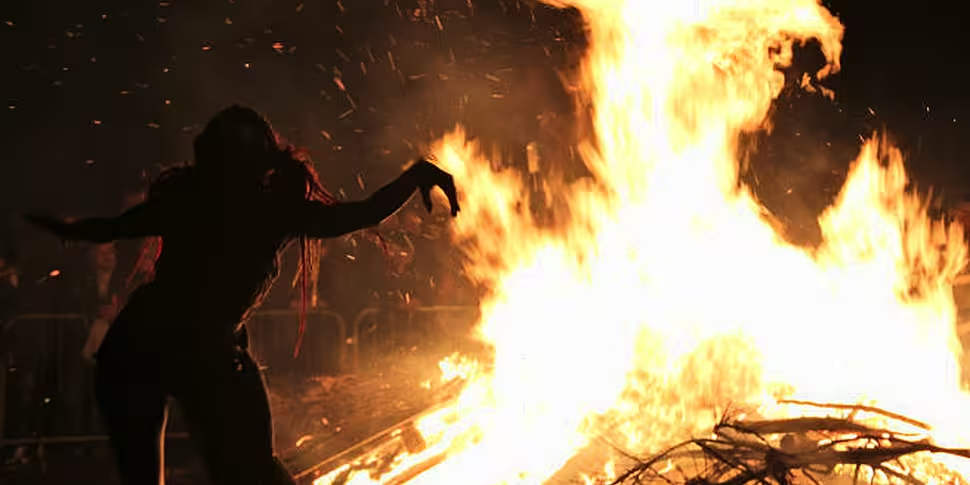Come ye young men, come along
With your music, dance and song
Bring your lasses in your hands
For ‘tis that which love commands
Then to the Maypole haste away
For 'tis now our holiday – ‘Staines Morris’
May Day celebrations reach far back in history. Across ancient Europe this time of year saw May Queens were crowned, great poles raised and adorned with coloured ribbons, and bonfires lit to celebrate to coming of summer. In Gaelic Ireland this festival was known as Bealtaine and was dominated by the huge fires that reflected its sister autumnal festival, Samhain. Across the island people led their livestock through the cleansing smoke of these bonfires while they danced and jumped around, and often through, the lucky flames.
Originally a festival celebrating virility and plenty, the coming of Christianity blunted many of May Day’s more hedonistic festivities. Yet the day itself endured and much of the world continues to celebrate the coming of summer in ways that echo back to these ancient practices. This Sunday ‘Talking History’ will be revisiting some of our most enjoyable discussions of the past year in celebration of May Day and the coming summer.
 May Day celebrations in Maryland USA in 1907
May Day celebrations in Maryland USA in 1907
Cocaine
It is no coincidence that the coming of summer was one of the most universally important celebrations across pre-Christian Europe. The longer, warmer days promised an easier and more enjoyable time to come with crops and fruit blooming in the fields and trees. Man’s instinctive love of that which makes us feel good made it natural that the myriad of May Day festivities would emerge.
This same celebrating of that which makes us feel good has seen the leaf of the coca plant, and its derivatives, raised up to a place of prominence in numerous societies throughout history. Growing in the mountainous Andean region of South America, the thin oval leaves of the coca plant produce a numbing euphoric energy when chewed. After these effects were realised the plant became an important element in many native Andean cultures; often taking on medicinal and religious significance.
At 7pm this Sunday ‘Talking History’ will be taking a look back at our discussion earlier this year on the history of cocaine. Journey back with ‘Talking History’ to the mountains of South America and the ancient Amerindian tribes and hear how the Spanish and Portuguese conquistadores turned the coca plant on the people who had revered it for so long.
Join Patrick as he and a panel of experts look at the synthesising of cocaine in the 19th century and the drugs coloured history since. How did something used and promoted by popes and monarchs become one of the world’s most demonised substances? Why have so many great minds been so enamoured by the coca leaf’s power? And what has cocaine’s ultimate role and impact in history been?
Apocalypse Now
One area that cocaine had a massive impact was in cinema. The drug fuelled the creativity and performances of many writers, directors, and actors; sometimes disastrously so. Today cocaine is one of the main drugs synonymous with Hollywood and the world of cinema. This isn’t, however, a new trend and the relationship between drugs and cinema goes far back.
One movie that has a strong reputation for drug use on set is Francis Ford Coppola’s ‘Apocalypse Now’. This movie retells Joseph Conrad’s great novel, ‘Heart of Darkness’, but changes the setting from 19th century Congo to the Vietnam War. The essence of ‘Heart of Darkness’ is kept intact, however, as Coppola delves into the corrupting essence of personal power and the brutality that comes with imperialisms clash with the native peoples’ otherness.
With its iconic scenes, instantly memorable dialogue, and deeply unsettling characters ‘Apocalypse Now’ is today regarded as one of the greatest movies ever made. During production and filming, however, the future of the movie and Francis Ford Coppola’s career was very uncertain. Filming in the jungles and beaches of the Philippines the project encountered obstacle after obstacle and was soon over due and drastically over budget.
Join ‘Talking History’ this Sunday as we round off our two hours of broadcasting with the story of how ‘Apocalypse Now’ made it to the big screen and became one of the most iconic movies of all time. Are the tales of rampant drug use and continuous partying true? Did Martin Sheen really almost die and Coppola threaten suicide? What is the story behind Marlon Brando’s accidental iconic appearance in the film? And how did this project go from almost ruining Coppola to become one of his masterpieces?









